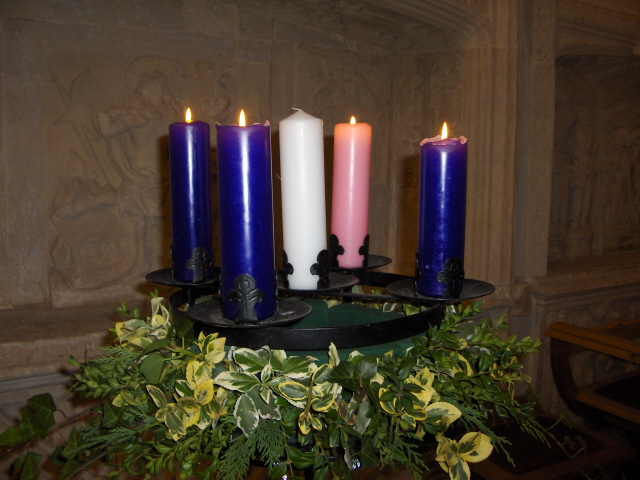Advent
The word Advent is derived from the Latin adventus, meaning, the coming. During this season we remember the twofold Advent of Jesus Christ: he has come to this world as our Saviour and he will come again to be our Judge. We therefore prepare ourselves to celebrate Our Lord’s first coming – his Birth – and to expect his second coming. (1)
This twofold Advent is evident in the hymns we sing during Advent and in the beautiful Collect for Advent Sunday:
“Almighty God,
give us grace to cast away the works of darkness
and to put on the armour of light,
now in the time of this mortal life,
in which your Son Jesus Christ came to us in great humility;
that on the last day,
when he shall come again in his glorious majesty
to judge the living and the dead,
we may rise to the life immortal;
through him who is alive and reigns with you,
in the unity of the Holy Spirit,
one God, now and for ever”. (2)
Advent is a season observed only in the Western Church. It dates back to the fifth century and originally there were six Sundays in Advent. These were reduced first to five and then to the four Sundays before Christmas Day. (3) Advent Sunday marks the beginning of the Church’s Year.
One of the best known Advent hymns is O come, O come, Emmanuel which is derived from the Great Advent Antiphons. Traditionally there are seven Antiphons, all beginning with ‘O’ and therefore often called the ‘O’ Antiphons. They were sung in the last week of Advent at the service of Vespers, before and after the Magnificat. In the Book of Common Prayer, December 16th is the date of the first Antiphon and in the Prayer Book Calendar you will see the words, ‘O Sapientia’ on that date. In Common Worship, as in the Roman Breviary, the start date is December 17th. The seven ‘O’s in Latin and English, in the order in which they are sung, one each day, are as follows:
O Sapientia-------O Wisdom
O Adonai---------O Lord
O Radix Jesse----O Root of Jesse
O Clavis David----O Key of David
O Oriens----------O Morning Star
O Rex Gentium---O King of the Nations
O Emmanuel------O Emmanuel (meaning ‘God is with us’)
When viewed backward from the last Antiphon to the first, the first letters of the Latin texts (shown in red above) spell out the Latin words ero cras, meaning ‘I come tomorrow’. (4) The Antiphons and the relevant scriptural references are included in Common Worship: Advent on pages 58-59.
Expectation, joy and penitence all intermingle during Advent and are reflected in hymns and readings. In keeping with the penitential aspects of the season, the liturgical colour is purple, the Gloria is not sung at the Eucharist and there are no flowers. However, Alleluias are joyfully sung; for example, in the Gospel acclamation.
Many churches have an Advent wreath with five candles – three purple and one pink round the outside and a white one in the centre. The circular wreath symbolises God himself who always was, and always is, and always shall be. The use of evergreens for the wreath symbolises the new life which God offers us here and now through prayer and the Sacraments, and the opportunity he gives us of eternal life with him in Heaven. On Advent Sunday one purple candle is lit. On the second Sunday in Advent two purple candles are lit.
The third Sunday is known as Gaudete Sunday because traditionally the Introit at the Eucharist begins with the words "Rejoice (Latin, Gaudete) in the Lord always". It marks the half-way point of Advent and there is joy that the celebration of Our Saviour’s Birth is getting very near. Traditionally, the priest wears rose-coloured vestments on Gaudete Sunday which is why the pink or rose-coloured Advent candle is lit on that day (along with two purple candles). Many churches, however, do not have rose-coloured vestments and purple is worn instead. On the fourth Sunday in Advent three purple candles and the rose candle are lit. The white candle in the centre represents Christ, the Light of the World, and this is lit at Christmas. The purple and rose candles are replaced with red or white candles for the Christmas season.

“Amen. Come, Lord Jesus!” (NRSV, Revelation 22:20)
References
1. Church Printing Company (1865) The lives of the saints; or, notes ecclesiological and historical on the Holy Days of the English Church, London: The Church Printing Company.
2. © The Archbishops' Council of the Church of England (2000) Common Worship: Collects and Post Communions in contemporary language. The first Sunday of Advent. Available from:
http://www.churchofengland.org/prayer-worship/worship/texts/collects-and-post-communions/contemporary-language/adventtoprelent.aspx (Accessed 25 November 2015) (Internet).
3. Dix, G. (1945) The shape of the liturgy, Westminster: Dacre Press.
4. Just, J. (2010) "O Antiphons" for the Week before Christmas. Available from:
http://catholic-resources.org/Lectionary/Advent-O-Antiphons.htm (Accessed 25 November 2015) (Internet).
Short talks
Short talks on the Four Last Things, Death, Judgement, Hell and Heaven are available in this section of the Holy Faith website. See also The preaching of John the Baptist: Repentance, Four Parables of Judgement and The Christian's joy. For the end of Advent, see Room in my heart?
Biblical references
Biblical references are included in brackets in the text. Other references are listed at the end of each talk. The Scripture quotations are mostly from The New Revised Standard Version of the Bible, Anglicized Edition, copyright © 1989, 1995 by the Division of Christian Education of the National Council of the Churches of Christ in the United States of America and are used by permission. All rights reserved. The initials NRSV are used at the end of these quotations.
A few quotations are from the Jerusalem Bible, copyright © 1966 by Darton, Longman and Todd Ltd and Doubleday & Company, Inc. The words Jerusalem Bible are used at the end of these quotations.
